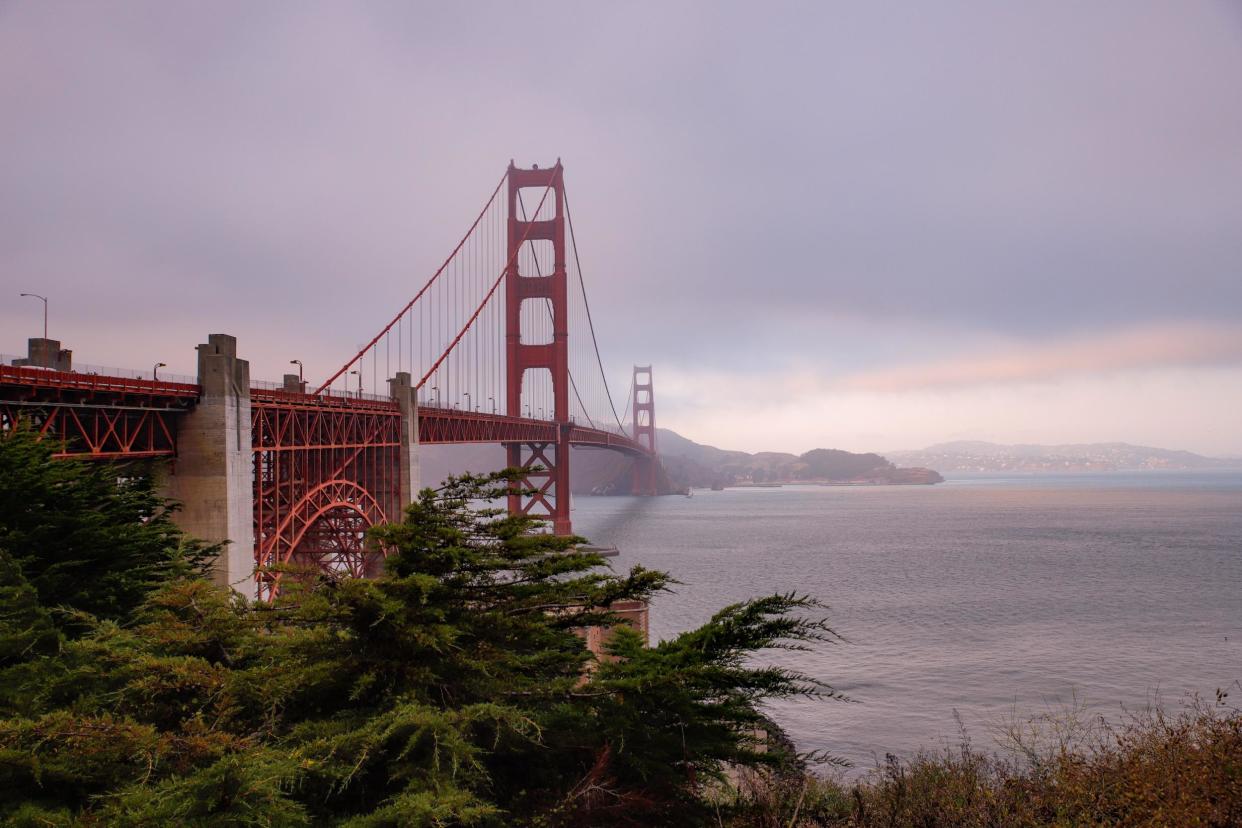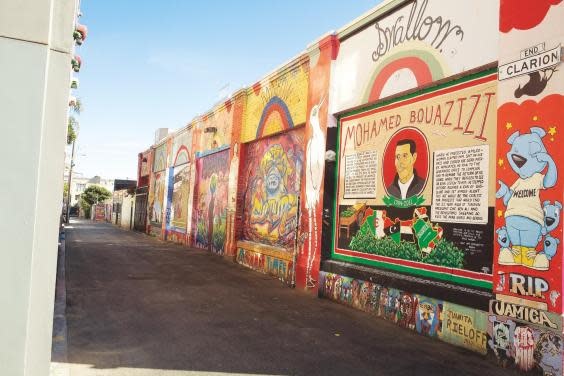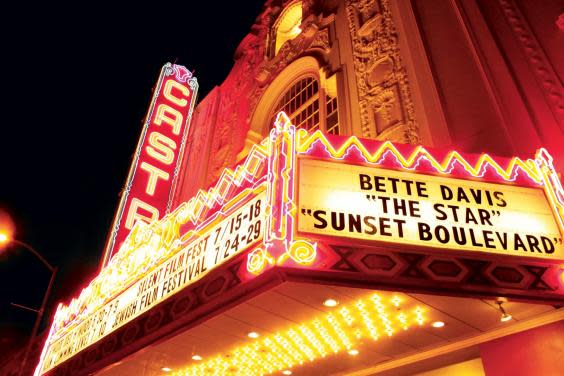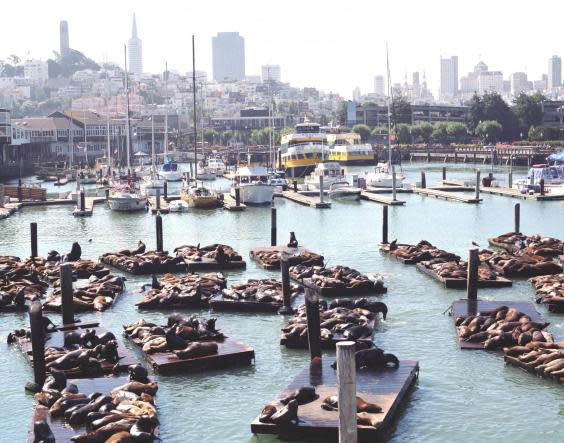Why 2020 is the year to visit San Francisco

It’s only on the last morning that the fog finally lifts and the Golden Gate Bridge shows its rust-red suspension cables. I’d almost caught it the day before, weaving madly through traffic in an Uber towards the viewing point, watching the pillows of cloud roll in across the bay. No luck – I was too late.
But on this stately Californian Sunday morning, all clear skies, wincing bright light and tech bros jogging around the trails of the Presidio, she makes an appearance and I pose unashamedly in front of her 227m height.
I know, I know. So touristy. But that’s not necessarily a bad thing in San Francisco, where some of the most recognisable landmarks spring from the city’s streets as readily as tech IPOs. Besides, it was my first visit to this rugged section of northern California – so give me a break. I wanted to see San Francisco’s icons, rather than the “under the radar” spots I usually seek out in Europe. Take that, travel writing!
People who have visited San Francisco more times than my measly, er, none told me there’s never a bad time to visit (even in November and December, when that pesky fog rolls in) – but by all metrics, 2020 is a good year to start with. Not that anniversaries are ever reasons to visit, but this year San Francisco ticks off all the big-ticket ones anyway. June marks the 50th anniversary of San Francisco Pride, set to be the US’s biggest-ever LGBT+ celebration; 2020 marks the 30th anniversary of the sea lions that clap about by Fisherman’s Wharf; and while we’re on the Golden Gate Bridge, this year is the 150th anniversary of the 1,000+ acres of the rectangular Golden Gate Park – featuring the superlative art and sculpture gallery De Young Museum and the Japanese tea garden.
Right at the top of my San Francisco bucket list was the Mission District, named after the Spanish missionaries who lived in this central corner of San Francisco during the late 18th century. While once it was conservative, today it is free-wheeling (of sorts): bright murals decorate any spare wall, and formerly drug-ridden Clarion Alley, right opposite the Mission’s police station, has gone from grimy to bohemian with an ever-so-slightly corporate whiff. (I learn that Clarion Alley is controlled by a non-profit organisation, and other tour guides, including Wild SF that are showing me about, are asked not to include the street in their tours – how very San Francisco.) I walk down it solo, and find colourful murals depicting gentrification, police brutality and the tech industry’s rising power spill across its walls, with slogans shouting “tax the rich” and “demoncracy”.

The rest of the Mission is a mix of fratty brewpubs popular with Facebook workers and down-at-heel restaurants: the main spine of Mission Street, so far, has resisted the call of gentrification. The last stop on the Wild SF tour is, fittingly, the Maestrapeace, a cathedral-like mural webbed across two sides of the Woman’s Building, featuring outsized women and images of female fun and friendship. Its four storeys of rainbow colours are a roll call of successful San Franciscan female artists.

Neighbouring the Mission, a 15-minute walk past the pastel, Italianate clapboard houses San Francisco is so recognisable for, is the LGBT+ neighbourhood of Castro, which is where this summer’s Pride will be felt most keenly. It was in the Castro in 1977 that activist Harvey Milk became a city supervisor – there’s a potted history of his life and death in the eponymous plaza by the metro – and rainbow flags have flown high here ever since. The Castro district, which fans out over a couple of blocks from the junction of Castro Street and 19th Street, is a loud celebration of everything LGBT+: the Soulcycle, opposite the wonderfully Art Deco Castro Theatre, is adorned with rainbow flags and the motto “hope will never be silent”; the Rainbow Walk honours lesbian, gay, trans and queer individuals that have left a lasting mark on society; and the Dog Eared Books shop dedicates itself to LGBT+ work and authors. Cheekily, there’s even a nail bar called “Hand Job”.

Everyone’s heard of Alcatraz, a rocky island blown a mile into the San Francisco Bay, otherwise known as the world’s worst prison. During a three-hour tour of the Alcatraz cellhouse (get an audio tour – it lifts the whole experience), which thrillingly outlines the jail-break attempts of 1948 and 1962, I’m struck by how close the inmates were to the city. If the wind blew the right way, the 12-minute ferry ride from the city is chiselled down to no distance at all, and to the inmates the sounds of San Francisco getting on with life would’ve sounded tantalisingly close.
The Alcatraz ferry drops us back off at Fisherman’s Wharf, a slightly tatty tourist trap of shops selling “I love SF” T-shirts, Golden Gate Bridge magnets and fish restaurants (although if you need to eat, the Fog Harbour Fish Harbour is a cut above the rest with its monstrously large portions). The reason we’re here? The boisterous pack of sea lions by Pier 39, who have been here three decades this year, following the 1989 Loma Prieta earthquake. The floppy, ugly way they roll off the wooden pontoons and heave themselves back up is remarkably spellbinding in the early afternoon sun.

Next tourist traps to tick off? The newly minted Chase Centre, which opened in September 2019, home to the city’s much-loved basketball team the Golden State Warriors and one of San Francisco’s most electrifying atmospheres during a home game; and dinner in Chinatown, the US’s oldest and the largest Chinese enclave outside Asia. We grab mooncakes – sticky-sweet, glutinous pies filled with lotus paste – and char siu bao from the Eastern Bakery, fortune cookies from the Golden Gate Fortune Cookie Company on dingy Ross Alley and traditional-ish Cantonese plates at... well, most restaurants.

Sunday morning dawns bright, and after ticking off the Golden Gate Bridge I’ve got another bridge in my sights: the Bay Bridge, which links San Francisco with its bigger, badder cousin Oakland across the water. It’s best seen from behind the terrifyingly large Beaux Arts Ferry Building, a late 19th century ferry terminal-come-food hall and posh Sunday flea market. Tourists are queueing up to get ferries across the bay, to cities including Oakland and Sausalito. And while in San Francisco, I’m quite happy to be included in their number.
Travel essentials
Norwegian flies from London Gatwick to San Francisco from £169.90 one-way.
Rates at the Kimpton Buchanan, a boutique-in-feel hotel in the heart of San Francisco’s Japantown, start from $209 (£160) a night. The neighbourhood is still ever-so-slightly off the city’s usual tourist-trodden beat, and is a fun place to find cutesy Japanese souvenirs (try the Daiso Japan shop in the mall) and superb (oversized) plates of sushi at Izakaya Kou on Fillmore Street.
For more information on San Francisco, visit sftravel.com

